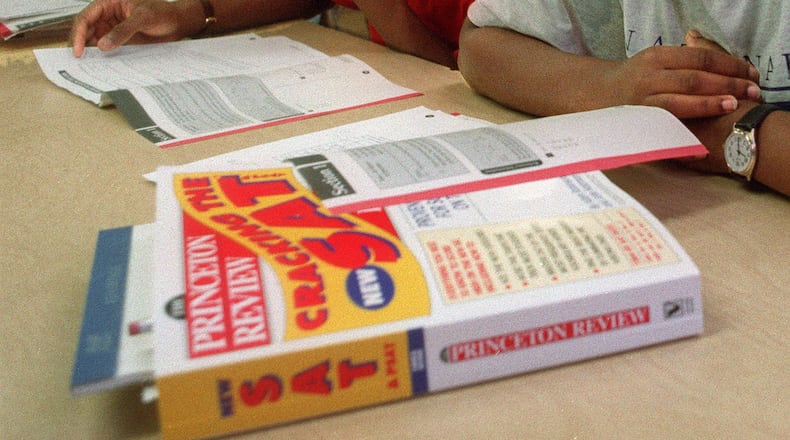The current lament in Georgia is that we send too many high school students to college who aren’t ready. A new study out of Virginia suggests we could be overlooking students who are ready.
A University of Virginia study released today asked what fraction of the students in Virginia who didn’t take the SAT would be revealed as candidates for four-year colleges and universities if they did take the test?
In the study "Missed Exams and Lost Opportunities: Who Could Gain from Expanded College Admission Testing?" researchers examined Virginia's 2014 graduating class, 44 percent of whom were "non-takers," meaning they didn't take the SAT.
Analyzing their academic and demographic data, the study predicts 24 percent of the non-takers would have posted a combined math and verbal score at or above 1000 out of a possible 1600. About 1,800 would have scored at levels high enough to qualify for consideration at the University of Virginia.
For comparison, the average mean SAT score for Georgia test-takers last year was 1064. While many Georgia colleges will accept students with an SAT of 1080, the most select schools are looking for scores above 1200.
The conclusion from the study:
We estimate that universal testing in Virginia could increase the number of high school graduates with test scores competitive for admission at broad-access universities in the state by as much as 40%—and at the most selective institutions by nearly 20%—with larger increases for low-income students. Alternative policies that encourage testing among students with strong demonstrated academic performance could realize nearly these increases without generating testing costs for students who are unlikely to attend a 4-year college.
Overall, institutions like Liberty University and Old Dominion University could expect their pool of potential students to increase by over 40%, while the University of Virginia and the College of William & Mary might gain just under 20% in the size of the potential pool of in-state students
The UVA study echoes earlier research suggesting universal testing deepens the pool of prospective students.
Who are these academically capable non-takers? They are likely to be economically disadvantaged and in small school districts.
Recognizing the high cost of paying for college admissions tests for every student, the study calculated the payoff from limiting school-financed testing to those who demonstrated academic promise on a statewide benchmark exam. Nearly nine out of 10 of the non-takers who would have attained college-ready SAT scores would be captured if Virginia limited testing to students who scored at or above the 40th percentile on the state’s 8th-grade Standards of Learning exams.
More colleges are adopting test-optional admissions policies, relying on grades and portfolios to vet applicants. However, in Georgia, most colleges still require the SAT or ACT.
The study cites benefits to requiring all students take the college admissions tests; their scores may put some students on a college track who weren’t considering it. And it brings those students to attention of college recruiters who use SAT and ACT scores to identify promising applicants.
“Admission tests provide critical information to students in two ways: first, the score can help a student create a well-matched application portfolio, and second, by taking an admission test, the student can participant in programs such as the College Board’s Student Search Service, which help colleges, scholarship programs, and other parties identify and reach out to students,” said Emily Cook, a coauthor and Ph.D. candidate at the University of Virginia.
According to a summary of the study by the American Educational Research Association:
"Our work reinforces the work of other studies which show that there are a substantial number of students well-positioned to enroll in college who miss the key step of taking a college admission test," said study coauthor Sarah E. Turner, a professor of economics and education at the University of Virginia's Curry School of Education. "Students from low-income families and those in relatively small districts are most likely to be absent from college admission testing."
The authors addressed whether higher education institutions would be able to accommodate a substantial increase in the pool of students. They note that the most selective universities in Virginia are engaged in proactive efforts to increase the representation of low-income students. While these institutions might not increase total capacity in response, one would expect that the representation of low-income students would increase, making the institutions more meritocratic. Other public universities in the state have demonstrated considerable elasticity in enrollment over time, while small private colleges would welcome increased enrollment.
The authors emphasize that admission tests are incomplete indicators of "college readiness" or of whether a student is "well-matched" or "admission-eligible" at a particular college.
"College admission test-taking is but one gateway step in the process of college choice. Guidance about whether and when to take college admission tests ideally would be situated in comprehensive and personalized interventions to help high school students make better informed postsecondary choices," said Turner. "Nevertheless, our findings provide further evidence that increasing the number of students taking admission tests can be beneficial."
About the Author
The Latest
Featured



